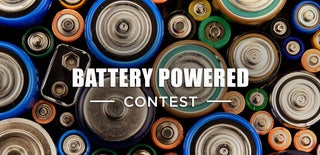Introduction: Middle of the Night Bathroom Light
Some of us experience the need to use the bathroom in the middle of the night. If you turn on a light, you may lose your night vision. White or blue light makes you lose the sleep hormone, Melatonin, making it more difficult to go back to sleep. So this little light uses one red LED, fastens to the wall, and gives just enough light to see without waking you up as much. The LED is on a swivel, and can be pointed in the desired direction. The housing is 3D printed.
Supplies
Push button (on-off switch) www.jameco.com part number 164494
Bright red LED www.jameco.com part number 2292991
47 ohm ½ watt resistor www.jameco.com part number 661351
Step 1: Make the 3D Printed Box
First, print the box, the corner of the box, and the ball on a 3D printer. I used 0.1 mm layer height, 0.4 mm nozzle, and 3mm wall thickness, and no support. I printed it with ABS plastic, but I think any plastic would work fine. I already added some support to the ball, which was easier to file off than the slicer-generated support. Load all three of these in the slicer (Cura is my slicer) to print at the same time, because the tiny ball and the corner of the box need each layer to cool just a little, while the box is getting a layer printed. I printed the lid separately.
About the files:
WallLight3.f3d is the design file for Fusion 360. It is only needed if you want to change something. Otherwise, just use the stl files to print the box, the corner of the box, the LED-holding ball, and the lid (which is actually the back, too).
Step 2: Install the Battery Contacts
The battery compartment has slots for metal contacts to connect to the batteries. On the right end in the photo is just a rectangle to connect the two batteries in series. The other end has individual pieces bent into a springy contact to hold the batteries in place and make contact. I used some sheet copper, but sheet brass or steel would work fine, too. You could use a steel food can as well. Cut the pieces with tin snips, pound them flat with a mallet or hammer, file the edges smooth, and sand off the coating (for a steel can) on both sides. Bend the spring ends, make sure they fit, and solder the wires to them while they are not inserted into the box, so the box doesn’t melt from the heat of soldering. I drilled a tiny hole to make connecting the wire easier. See the drawing for the dimensions.
Step 3: Prepare the Light
I lined the lighted, funnel end of the ball with aluminum tape. This gives a little more light, and is not absolutely necessary. Instead, some white or silver paint would also increase the light. Cut the tape into little triangles, and place a third or fourth of it at a time. Burnish down where the pieces overlap, and trim the excess with a knife.
Add some thin, stranded wires to the leads on the LED. The flexibility of the thin wires will allow the ball to swivel more easily. Make sure to be aware which lead is positive: the longer lead is positive, and there is also a flat on the side of the LED base rim next to the negative lead. I took some (#26) wire out of a piece of Ethernet cable, and two different colors help keep positive and negative leads identified. I cut the leads of the LED to ½ inch in length. Clamp some needle-nosed piers or something metal right next to the LED to act as a heat sink, and prevent the heat of soldering from damaging the LED. The LED is then glued with epoxy into the ball. The epoxy is placed at the back of the LED, since any glue that gets on the round dome of the front of the LED will interfere with the light coming out.
Step 4: Wire the Circuit
The most critical part is that the positive of the LED is connected to the positive of the battery.
The light can be made dimmer with a larger value of resistor, like double or four times the resistor value. Likewise, it can be made brighter with a smaller value, but don't use less than 16 ohms or you can overload the LED. A dimmer light will give longer battery life, and a brighter light will give shorter battery life. I found that the value that I used worked nicely.
Step 5: Put It Together and Mount It
The corner of the box slides right into the main box, and holds the ball/LED in place. The back cover slides into place and holds the corner piece in place. The corner piece may require a little filing or sanding to remove the roughness of the 3D print process. Similarly, the ball and the socket for the ball may need a little smoothing, although it is good to have some grip to keep the ball from moving out of position after you adjust it.
I mounted mine to the wall with two #6 by ½ inch round head sheet metal screws, into plastic wall anchors. Double stick foam tape would stick it to the wall as another method.
The two AA batteries should give about 105 hours of use, which translates to about 1-2 years of having it on for a few minutes each night.
Now you can see in the middle of the night!

Runner Up in the
Battery Powered Contest
















